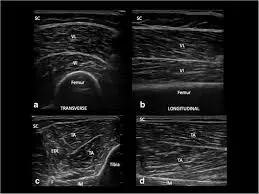How to Interpret Muscle Ultrasounds: 3 Key Techniques
Muscle ultrasound is a valuable diagnostic tool used to assess the health and condition of muscles. This guide will explore the use of muscle ultrasounds, what they can show, and methods for interpreting the findings.
What is Muscle Ultrasound?
Muscle ultrasound is a non-invasive imaging technique that uses sound waves to visualize muscle tissue, tendons, and ligaments. It is a safe, cost-effective, and real-time imaging modality used for diagnosing various conditions.

What Can Muscle Ultrasound Show?
- Muscle Injuries: Detects tears, strains, and hematomas within muscles.
- Tendon and Ligament Issues: Visualizes tendinitis, tendinosis, and ligament sprains or tears.
- Masses and Tumors: Identifies abnormal growths or masses within soft tissues.
- Fluid Collections: Detects fluid buildup or cysts around muscles.
- Real-time Assessment: Allows for dynamic assessment of muscle movement and function.
- Guided Procedures: Assists in guiding needle injections or biopsies for diagnostic and therapeutic purposes.
Why Might You Need a Muscle Ultrasound?
- Muscle Pain and Swelling: To evaluate the cause of discomfort, inflammation, or swelling in muscle tissue.
- Sports Injuries: Used to diagnose muscle and tendon injuries from athletic activities.
- Soft Tissue Masses: To assess any palpable lumps or bumps under the skin.
- Painful Tendons: To evaluate for conditions such as tendinopathy or tenosynovitis.
- Guided Injections: For accurate guidance when administering targeted medications or treatments.
- Post-Surgical Assessment: To monitor recovery and healing of musculoskeletal tissues.
How to Interpret Muscle Ultrasound Results
Interpreting muscle ultrasound images requires understanding both the normal anatomy of muscles and common pathological findings. Here are three ways you can approach this process.
1. Utilizing X-ray Interpreter
X-ray Interpreter offers AI-driven analysis to help with ultrasound interpretation:
- Register: Sign up at X-ray Interpreter to use our AI for ultrasound analysis.
- Upload Images: Upload your muscle ultrasound images to the platform.
- Receive Report: Review the AI-generated interpretation report.
- Consultation: Always discuss the results with your healthcare provider.
Check our get started guide for more details.
2. Using ChatGPT Plus
ChatGPT Plus, powered by GPT-4V, can also help analyze ultrasound images:
- Subscription: Subscribe to ChatGPT Plus for advanced AI capabilities.
- Upload Images: Upload your ultrasound images to the platform.
- Request Analysis: Ask ChatGPT to analyze the ultrasound images.
- Review: Review the provided interpretation and confirm accuracy with a healthcare professional.
Read more in our blog on using ChatGPT Plus for medical image interpretation.
Alternatively, as several other AI models with vision capabilities emerge, you can also try other models, such as Grok by xAI, Claude by Anthropic, Gemini by Google Deepmind.
3. Understanding the Basics Yourself
Learning the basics about muscle ultrasounds can empower you to ask more informed questions from your healthcare provider.
- Learn Muscle Anatomy: Familiarize yourself with basic muscle anatomy and tissue structures.
- Research Common Findings: Research typical muscle ultrasound results and presentations.
- Ask Questions: Note any unfamiliar terms and ask your doctor for clarifications during your follow-up.
- Seek Expert Guidance: Always confirm your self-interpretations with a qualified healthcare professional.
Comparing the Different Approaches
Here's how these interpretation methods compare across key criteria:
| Criteria | X-ray Interpreter | ChatGPT Plus | Self-Reading |
|---|---|---|---|
| Accuracy | High (AI-based)1 | High (AI-based)1 | Varies (Skill-dependent) |
| Ease of Use | Easy | Moderate | Challenging |
| Cost | Starting from $2.50 per image | $20 per month | Free (excluding educational costs) |
| Time Efficiency | Fast | Moderate to Fast | Slow to Moderate |
| Learning Curve | Low | Low to Moderate | High |
| Additional Resources | Provided | Partially Provided (through OpenAI) | Self-sourced |
Each approach has benefits. AI provides fast, precise analysis while a basic understanding aids patient-doctor communication.
Conclusion
Muscle ultrasound is a powerful tool for diagnosing muscle and soft tissue conditions. This guide provided an overview of the images it produces and ways you can enhance your understanding, utilizing AI or foundational knowledge.
When choosing a method, keep your specific needs, level of understanding, and the resources available in mind. Seek confirmation of the results with your doctor and be aware of privacy standards.